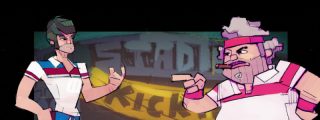In the long ago of the 1990’s and the far far away of South America, a young Lucio spent his summers bouncing around Argentina visiting family, spending time in places where cable was virtually non-existent. This has since changed. Family members that live in the middle of nowhere now have more channels with better resolution that I do in a major metropolitan area in the United States. But I digress. During the hot hours after lunch as the older people took their siestas, I, along with whatever cousin was near, would watch old badly dubbed movies. Among the most common of these: Spaghetti Westerns. Hard West, a squad based strategy game set in the old west by Polish developer Creative Forge Games, might not reach the levels of melodrama that a long, drawn out triple Mexican stand off can conjure up, but in some ways it captures the feeling of danger, chaos and superstition of these movies.
The lazy man’s way to describe Hard West would be to call it “X-COM with cowboys” and call it a day. But this isn’t really correct, even at a superficial level. They belong to the same genre, yes, and there are some superficial similarities in the HUD and the look of the game. That is about where the similarities end. Hard West is a game that is much more story driven. There is a central narrative that is carried by a loose theme. The main story concerns Warren, a prospector turned outlaw, turned undead spirit of revenge by the devil’s foul play and circumstance. However he is not the only character that is featured in the story. The game is divided in scenarios, which do not always follow the protagonist, but are related to the overall story. You will start by following Warren’s misadventures as a prospector in the wild west, but after you complete the first scenario the game will give you different choices of the stories you want to see. You can follow Warren’s story, or see some of the complementary narratives.
Once you choose your scenario you will be treated to a short narrative, and usually a thrown immediately into a combat map. Once you clear the tactical section, you are let loose on a small map. You can click on any of the many icons and that will take you to them. There are a variety of things going on here. There are towns with stores you can buy guns or supplies at, but more common are places where you are asked to make a choice. These can lead to uncovering new items or bonuses, but they can also result on status ailments that can affect your characters during the combat stages. They are also used to tell the story via a voiced narrator. It is a clever way to tell the story and put what in most strategy games is the set up section all in an interface that feels a little more active than other games. It is not as deep as X-COM’s base building or as story driven as Fire Emblem or Final Fantasy Tactics, but it is a nice compromise between the two.
These scenario have a couple of turns that I found particularly interesting. The first one being that Creative Forge uses them to add puzzles into the game. In one section you can obtain a particularly strong piece of equipment that is buried in one of five graves on the map. You must follow clues in a note to guess the correct one. If you are wrong, then you will have negative effects applied to your character in the next battle map. It is an interesting way to add puzzles to a genre which doesn’t really have them, and while they are not really very complex I still liked the mechanic wished there had been more of them.
Each scenario also has its own mechanics, which keeps things fresh. The introductory scenario will have you living the life of a prospector. Spending money to make money and get that gold we all want so much. In another scenario you will mount an expedition, which means managing men, supplies, and money in a fashion that is reminiscent to Oregon Trail. Variety is the spice of life, and this will make sure that the sections between maps won’t get dull. The one thing about this approach that bothers me is that since the scenarios are stand alone, a lot of the allies and the items you unlock do not carry. So you can do an excellent job in the previous scenario, but that won’t affect your starting position in the next one you play. Why bother exploring everything and making sure you have all the items aside from your own curiosity? All it really does is encourage the play to look only to the next challenge rather than plan for the long term.
Where the lack of continuity between scenarios becomes most frustrating is in the game’s card system. Instead of having a level progression with skill and perks like many games of this type, Hard West has a card based system. Cards are unlocked through actions taken during battles or decisions made in the sections between these battles. Each card represents one of the four suits, and have bonuses and even special abilities that you can equip every character. In addition to this, you will get more bonuses by arranging them in a way that they make poker hands. For example, a pair will increase mobility, while a triple will increase HP. It is a very interesting system that encourages specific builds by grating certain combinations of cards bonuses, but remains flexible enough to let you customize characters to your needs. This makes it incredibly painful when the game takes these cards away when you move from one scenario to another. It is a question of balance for some maps, since you have some control on the order in which you tackle the scenarios some cards, like Golden Bullet and Ricochet can eliminate the challenge in certain maps. That being said it feels like more of a punishment than anything. There has to have been a more elegant way to handle transferring items between scenarios.
The combat stages are well done. You will have a posse, usually between two and four people, and will be asked to fulfill an objective. These objectives are nothing unexpected by the standards of the genre; kill everyone, survive for a specific number of turns, go to specific points in the map, kill a specific enemy, etc… There are some levels that also have optional, or side objectives, but ultimately nothing stands out as brand new. You are able to sneak in some maps, allowing you to get to a better position before the shooting starts, although you are under the risk of the enemies realizing you are there and shooting first.
I was surprised by how good the AI of the enemies is during these sections. Enemies will immediately seek cover in most cases, and will actively move to attempt to flank your team members. Perhaps more impressive is that they will move to better cover based on where you are and if you are trying to flank them. While the AI occasionally will leave a character out in the open, but I was still surprised by how well they adapted. The activities that you did between missions can affect these scenarios. For example, you can choose to poison the water supply of your enemies, and they will have lower HP when you get there.
There are a few other things that make the combat sections interesting, aside from the AI and the cards. A lot of the materials can be shot through, which means that cover won’t always provide 100% protection. Granted, it will still be hard to hit someone in cover, and it will do a lot less damage, but in a game where a character has between 5 and 9 HP, losing 1 or 2 is can still make a huge difference on your chances to win the battle. The game will also let you see the shadows of where enemies are, or give your characters powers based on being on the shadows or in the light, which makes the interplay with the environment more involved than just being a bunch of obstacles to take cover behind. It is still what they are, in essence, but now there is a little more thought to the environment when you are planning your moves.
Hard West is an incredibly tight tactical game with enough new ideas in between missions to set it apart from the pack. Creative Forge’s willingness to take some chances with a well-traveled genre has created a game that can definitely stand on its own. That being said the lack of persistence between the scenarios really hurts the game and cripples a lot of the incentive to do extra tasks, or to even try to keep non essential members of your posse alive through particularly difficult sections. It is a problem that really drags down the game overall. That being said this is by no means a deal breaker. If you are looking for a solid strategy game with tight tactical gameplay, and new and unique mechanics, Hard West is an excellent choice.
This review was done using review code provided by the publisher.











